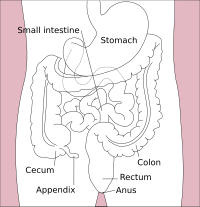
Photo from wikipedia
Objective The diagnostic value of optical enhanced endoscopy in early cancer of upper digestive tract was studied by comparing the disease accuracy, tumor type, invasion, and various surgical indicators between… Click to show full abstract
Objective The diagnostic value of optical enhanced endoscopy in early cancer of upper digestive tract was studied by comparing the disease accuracy, tumor type, invasion, and various surgical indicators between the two groups. Methods 188 patients with early upper gastrointestinal cancer treated in our hospital from January 2020 to February 2021 were selected as the research objects. The patients were randomly divided into the observation group and control group with 94 cases in each group. Results The accuracy of early detection of early carcinoma of upper digestive tract in the observation group was 94.68% and that in the control group was 76.60%. The accuracy of the observation group was significantly higher than that in the control group, with statistical significance (P < 0.05). In the observation group, 36 cases of early gastric cancer, 28 cases of early esophageal cancer, and 30 cases of early colorectal cancer were detected; 25 cases of early gastric cancer, 19 cases of early esophageal cancer, and 28 cases of early colorectal cancer were detected; 26 cases of early carcinoma of upper digestive tract infiltration were detected; and 68 cases were not detected, and the detection rate was 27.66%, which was higher than 9.57% in the control group, and the difference was statistically significant (P < 0.05). After different methods of treatment, no death occurred in all patients. Except for the operation time, the surgical indexes of the observation group were better than the control group, the difference was statistically significant (P < 0.05). Conclusion Optical enhanced endoscopic technique had obvious effect in the diagnosis of patients with early cancer of upper digestive tract, it was helpful to improve the clinical detection rate of early carcinoma of upper digestive tract and had certain diagnostic ability for the invasion depth of early cancer of high upper gastrointestinal tract, which was conducive to the detection of clinical invasion lesions and had high clinical promotion and application value.
Journal Title: Computational and Mathematical Methods in Medicine
Year Published: 2022
Link to full text (if available)
Share on Social Media: Sign Up to like & get
recommendations!